It looks like you're using an Ad Blocker.
Please white-list or disable AboveTopSecret.com in your ad-blocking tool.
Thank you.
Some features of ATS will be disabled while you continue to use an ad-blocker.
11
share:
Part 1:
A new book of drawings, attributed to Vincent Van Gogh, is about to be released to the public.
The book is entitled Vincent Van Gogh, le brouillard d’Arles (Trans: Vincent Van Gogh, the Fog of Arles). It will appear in English as Vincent van Gogh. The Lost Arles Sketchbook.
The story of the discovery of the book of drawings is told at the following link:
Sketchbook Attributed to van Gogh Pits Scholars Against a Museum
www.nytimes.com...
And here, among other places:
‘Lost’ van Gogh sketches disputed by Van Gogh Museum
www.thestar.com...
The scholarly refutation of the attribution of the drawings to Van Gogh can be found here:
Found Sketchbook With Drawings Is Not By Van Gogh, According To Van Gogh Museum
www.vangoghmuseum.nl...
The Van Gogh Museum has dealt, in a very matter of fact way, with a list of indications showing that the drawings cannot be from the hand of Van Gogh.
They deal with the sort of things that will be familiar to fans of the BBC television program Fake or Fortune; art forensics, provenance, subject manner, position within the artist's oeuvre, biographical details, suspect materials and judgments of the works based on connoisseurship.
These are things that will be discussed and debated by the experts. I am certainly no expert but I am an artist . . .
(This water color sketch of Chelsea Clinton from 15 years or so ago is only shown by way of bona fides, to assure the reader that I do know something about the subect.)

. . . and I think I can amplify what the experts at the Van Gogh Museum had to say out of knowledge they have accumulated under the category of connoisseurship.
Quoting their statement:
Let's look at some drawings that have been authenticated as the work of Vincent Van Gogh.
Sketch 1, Arles:`
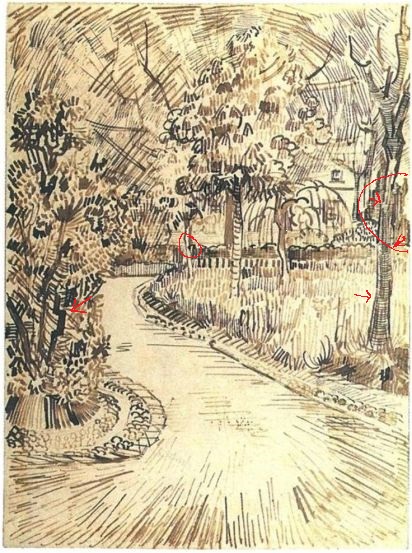
This sketch, we are told, was made in Arles and in the background includes a portion of the famous "Yellow House" that Van Gogh lived in during part of his time in Arles. It is a real van Gogh and shows the kind of stylistic use of simple, short lines that characterize so many of his drawings. It is a very busy drawing with lots of lines depicting a visually complex scene.
I've indicated (with red markings) a couple of things I want the reader to note.
First of all, the circled portion of the drawing, in the middle. Here, Van Gogh has made an incredible error. He has allowed a line from the shrubbery in the background to overlap the trunk of a tree closer to us, a physical impossibility.
Of course I am being facetious, but only to point out how incredibly neat this drawing is, despite being composed of a very large number of lines together, but not in the least jumbled. Anyone makes mistakes occasionally but looking at a large number of Van Gogh drawings, the characteristic that predominates, by far, in the housekeeping department, is not sloppiness but rather fastidious neatness.
There are four arrows in the drawing indicating another of his stylistic characteristics, that being frequently building up plant structure, like tree trunks for example, in sections. I'm convinced that he would draw one section and then fill in the background around it, and possibly go to another part of the drawing, perhaps at the same vertical level, before returning to extend the trunk a little further, all the while checking it against the already completed parts of the drawing and gradually building up the whole drawing, very importantly, keeping it an integrated unit all the way through.
There is another circle on the right of the drawing where the view seems to extend up the street past the corner of the Yellow House. It is not clear what we are seeing. Is it a tree? Is it one or more buildings, possible on both sides of the street?
The importance of this is not so much to determine what Van Gogh was depicting here, but rather to note that he gave this trailing off part of his image some considerable attention. It wasn't just a throw away space. It is a kind of "vanishing point", where a depth of further detail in the world is suggested.
Sketch 2, presumably Holland
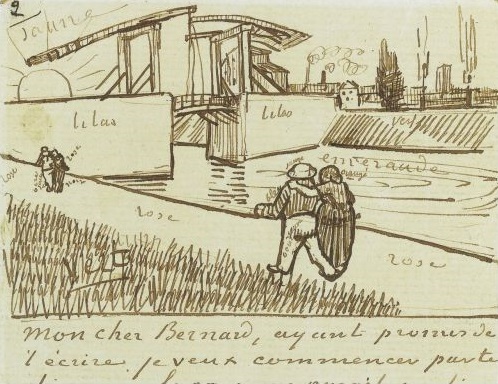
This is another real Van Gogh, excerpted from one of his letters.
This is a very simple drawing, near, I should think, to being just about as simple as Van Gogh gets with this sort of thing. The names of various colors are written in to remind him of his visual impression and conception for a planned painting.
Although the foreground is done in a very hasty and cursory manner and although the rest of the drawing is done very simply, the composition is tight, well observed and authoritative. One smiles, looking at the superstructure of the bridge. It's cute. He wanted to get it just so. Visually, it interested him.
This sketch snaps together smartly, and lives. It lives. Even at his most simple Van Gogh's work lives.
It is important to keep this in mind.
Sketch 3, the Yellow House, Arles
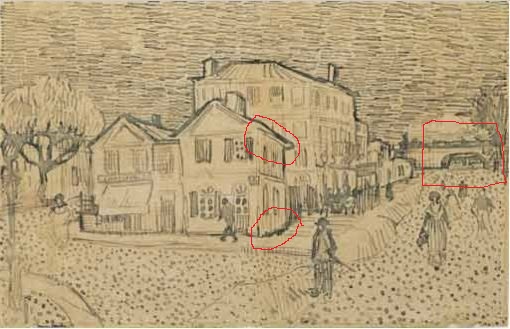
This is the last of the real, authenticated Van Gogh sketches that I want to look at. The cobblestone sky and the dotted cobblestones of the street are typical elements of Van Gogh's style.
His work often suggests in similar stylistic ways, the unity of nature, the oneness of everything and the notion that it is all composed of bits that are perhaps more similar than we generally think.
I've circled a couple of places in the drawing where his attention to consistent perspective has gone awry. Usually in his work, the overall scene is very acceptable to the eye in matters of perspective. In this case, these details are anomalous, but this is still a real Van Gogh, so finding an anomaly in a drawing would not automatically exclude it from Van Gogh's oeuvre.
In other words, nit picking of this sort, would not, I believe, constitute a substantial enough objection to a work to justify dismissal.
The red square at the right encloses another example of how the artist, typically, will not throw away the trailing portion of a scene. Instead, he induces the "thousand yard stare", bringing the viewer right into the picture, observing detail of the two railroad bridges down the street. Its a picture that insists on the larger world beyond the frame.
Allied bombers, in 1944, attempting to destroy those bridges, also destroyed the Yellow House.
A new book of drawings, attributed to Vincent Van Gogh, is about to be released to the public.
The book is entitled Vincent Van Gogh, le brouillard d’Arles (Trans: Vincent Van Gogh, the Fog of Arles). It will appear in English as Vincent van Gogh. The Lost Arles Sketchbook.
The story of the discovery of the book of drawings is told at the following link:
Sketchbook Attributed to van Gogh Pits Scholars Against a Museum
www.nytimes.com...
And here, among other places:
‘Lost’ van Gogh sketches disputed by Van Gogh Museum
www.thestar.com...
The scholarly refutation of the attribution of the drawings to Van Gogh can be found here:
Found Sketchbook With Drawings Is Not By Van Gogh, According To Van Gogh Museum
www.vangoghmuseum.nl...
The Van Gogh Museum has dealt, in a very matter of fact way, with a list of indications showing that the drawings cannot be from the hand of Van Gogh.
They deal with the sort of things that will be familiar to fans of the BBC television program Fake or Fortune; art forensics, provenance, subject manner, position within the artist's oeuvre, biographical details, suspect materials and judgments of the works based on connoisseurship.
These are things that will be discussed and debated by the experts. I am certainly no expert but I am an artist . . .
(This water color sketch of Chelsea Clinton from 15 years or so ago is only shown by way of bona fides, to assure the reader that I do know something about the subect.)

. . . and I think I can amplify what the experts at the Van Gogh Museum had to say out of knowledge they have accumulated under the category of connoisseurship.
Quoting their statement:
Furthermore, in contrast with Van Gogh's artistic achievements, the drawing style of the maker of the drawings in The Lost Arles Sketchbook is, in the opinion of our experts, monotonous, clumsy, and spiritless. Van Gogh's characteristic refinement – which includes his ability to draw swiftly without sacrificing precision, his profound sense of chiaroscuro and the skillful way he integrated an enormous range of drawing techniques into a compelling whole – is not in evidence in these drawings.
Let's look at some drawings that have been authenticated as the work of Vincent Van Gogh.
Sketch 1, Arles:`

This sketch, we are told, was made in Arles and in the background includes a portion of the famous "Yellow House" that Van Gogh lived in during part of his time in Arles. It is a real van Gogh and shows the kind of stylistic use of simple, short lines that characterize so many of his drawings. It is a very busy drawing with lots of lines depicting a visually complex scene.
I've indicated (with red markings) a couple of things I want the reader to note.
First of all, the circled portion of the drawing, in the middle. Here, Van Gogh has made an incredible error. He has allowed a line from the shrubbery in the background to overlap the trunk of a tree closer to us, a physical impossibility.
Of course I am being facetious, but only to point out how incredibly neat this drawing is, despite being composed of a very large number of lines together, but not in the least jumbled. Anyone makes mistakes occasionally but looking at a large number of Van Gogh drawings, the characteristic that predominates, by far, in the housekeeping department, is not sloppiness but rather fastidious neatness.
There are four arrows in the drawing indicating another of his stylistic characteristics, that being frequently building up plant structure, like tree trunks for example, in sections. I'm convinced that he would draw one section and then fill in the background around it, and possibly go to another part of the drawing, perhaps at the same vertical level, before returning to extend the trunk a little further, all the while checking it against the already completed parts of the drawing and gradually building up the whole drawing, very importantly, keeping it an integrated unit all the way through.
There is another circle on the right of the drawing where the view seems to extend up the street past the corner of the Yellow House. It is not clear what we are seeing. Is it a tree? Is it one or more buildings, possible on both sides of the street?
The importance of this is not so much to determine what Van Gogh was depicting here, but rather to note that he gave this trailing off part of his image some considerable attention. It wasn't just a throw away space. It is a kind of "vanishing point", where a depth of further detail in the world is suggested.
Sketch 2, presumably Holland

This is another real Van Gogh, excerpted from one of his letters.
This is a very simple drawing, near, I should think, to being just about as simple as Van Gogh gets with this sort of thing. The names of various colors are written in to remind him of his visual impression and conception for a planned painting.
Although the foreground is done in a very hasty and cursory manner and although the rest of the drawing is done very simply, the composition is tight, well observed and authoritative. One smiles, looking at the superstructure of the bridge. It's cute. He wanted to get it just so. Visually, it interested him.
This sketch snaps together smartly, and lives. It lives. Even at his most simple Van Gogh's work lives.
It is important to keep this in mind.
Sketch 3, the Yellow House, Arles

This is the last of the real, authenticated Van Gogh sketches that I want to look at. The cobblestone sky and the dotted cobblestones of the street are typical elements of Van Gogh's style.
His work often suggests in similar stylistic ways, the unity of nature, the oneness of everything and the notion that it is all composed of bits that are perhaps more similar than we generally think.
I've circled a couple of places in the drawing where his attention to consistent perspective has gone awry. Usually in his work, the overall scene is very acceptable to the eye in matters of perspective. In this case, these details are anomalous, but this is still a real Van Gogh, so finding an anomaly in a drawing would not automatically exclude it from Van Gogh's oeuvre.
In other words, nit picking of this sort, would not, I believe, constitute a substantial enough objection to a work to justify dismissal.
The red square at the right encloses another example of how the artist, typically, will not throw away the trailing portion of a scene. Instead, he induces the "thousand yard stare", bringing the viewer right into the picture, observing detail of the two railroad bridges down the street. Its a picture that insists on the larger world beyond the frame.
Allied bombers, in 1944, attempting to destroy those bridges, also destroyed the Yellow House.
edit on 16-11-2016 by ipsedixit because: (no reason given)
Part 2:
Now I want to go on to examine drawings which have been put forward as authentic pieces by Van Gogh, but which have been rejected by the Van Gogh Museum for numerous reasons, including ones related to connoisseurship.
I have only looked at four of these drawings, which have been published on line. I will not be addressing any forensic, or technical detail related to materials used or provenance. I will be pointing out things that caught my eye, as an artist, and which I believe would catch the eye of a Van Gogh connoisseur.
Brouillard Sketch 1:
This is the sketch that is featured on the cover of the soon to be released book, Vincent van Gogh. The Lost Arles Sketchbook.
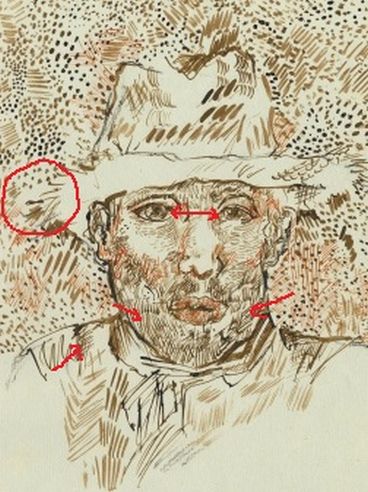
When I first looked at this drawing, I thought, "Wow! This is interesting.", but the more I looked at it, and knowing that there was controversy, I thought, "This is very like Matisse in the background."
The next thing I noticed, which was a big red flag for me was the circled area at the left of the picture, the edge of the hat.
Artists are very interested in the edges of things and have numerous ways of drawing and not drawing them, for effect.
Here, the artist has drawn the edge of the hat and then left a lacuna between the hat and the rest of the background. It is my opinion that doing this part of the drawing in this way is a serious breach of Van Gogh's esthetic, even in a sketch.
One also can't fail to notice immediately, although I did fail to notice it, the large discrepancy between the irises of the two eyes. It would not surprise me in the least to find similar discrepancies in authenticated Van Gogh works, but this discrepancy seems particularly egregious, especially considering the deliberate, methodical way in which I believe Van Gogh "built" a drawing, in small increments, always comparing parts to make sure that they remained integral with the whole of the work.
The beard seems to me to be overworked in an untidy manner, not stylistically compatible with Van Gogh's other work.
The background also, is too busy, too random, too ill considered to be typical of Van Gogh.
In addition to the above, I want to make a subtle point.
My impression of this work is that it is the reverse of what one would expect from Van Gogh drawing, in which stylistic elements, "tools" really, are used to create a drawing as an expression of the artist's vision and conception.
In the case of this drawing my feeling is that a drawing was the starting point, which was used as a vehicle to display the "tools" of Van Gogh. In other words, the whole point of this particular work is not to express an artist's conception, but rather to express an artist's style.
This work was done by a real artist/forger, but not by Van Gogh, in my opinion.
Brouillard Sketch 2:
This next sketch, attributed to Van Gogh, is for me the most annoying of the ones I have seen, because it violates what I firmly believe was Van Gogh's basic modus operandi, which was to work all over the drawing, building it up, knitting it tightly together and keeping it integrated all the way.
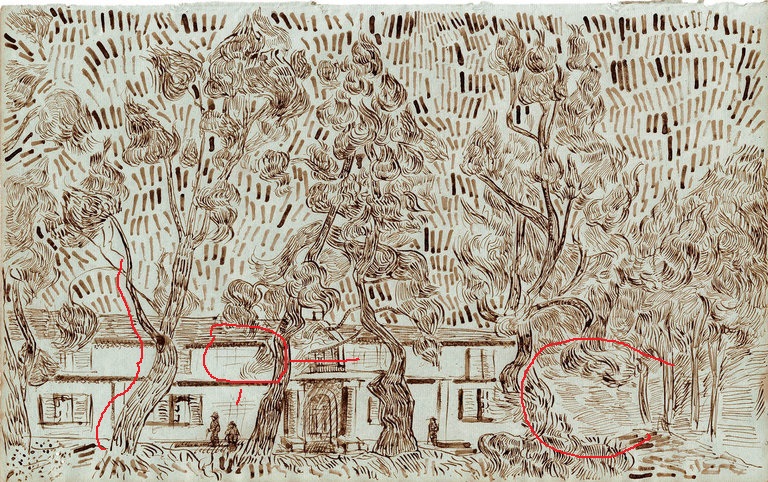
In this sketch, the trees would appear to have been done first and the building and sky put in afterward. Note the long curving section of the tree trunk on the left, which was definitely carried well above the roof line in one passage of drawing. To me that is not typical of Van Gogh.
Notice how some windows are done very nicely and others are just indicated in a very cursory fashion. One might say, "Well it's a sketch and he was hurrying. He just didn't bother finishing them." Van Gogh, even in a simple sketch, doesn't operate that way, and this is not a simple sketch.
We have seen that he is neat and fastidious in his work.
Notice, circled at the right, the trailing edge of the sketch, the "no throw away zone", one might call it. Here it is thrown away. There is no peek at the background, no look at the distance, no invitation into the world of the drawing. It is very unlike Van Gogh to do that.
I don't think this drawing is by Van Gogh. It's a pastiche of things we see in his paintings. I am not a connoisseur of Van Gogh. I have not studied his work as an expert would. I am reacting as an artist. To me, this is a mess and Van Gogh is not messy.
Brouillard Sketch 3:
I have only looked at four of the drawings from the book. One of these, "water, sky and sail boats", for lack of a title, seems altogether too limp to be a Van Gogh. There is not much of mind or of life in it, in my opinion. If it lives, it is on life suport.
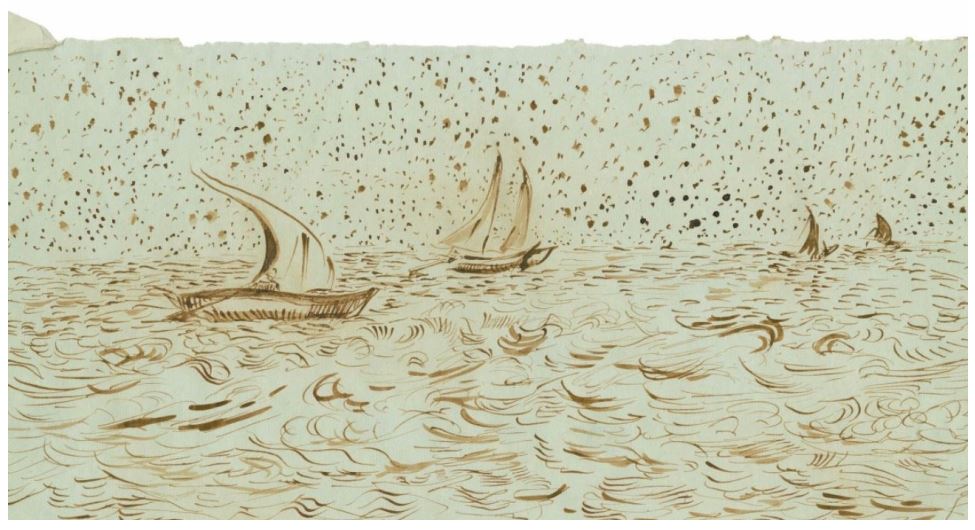
Brouillard Sketch 4:
This last sketch, of the four I looked at, is a pleasant drawing, showing some skill in the handling of the grasses in the foreground, but still, there is slapdash non Van Gogh-ian "filler" in there too.
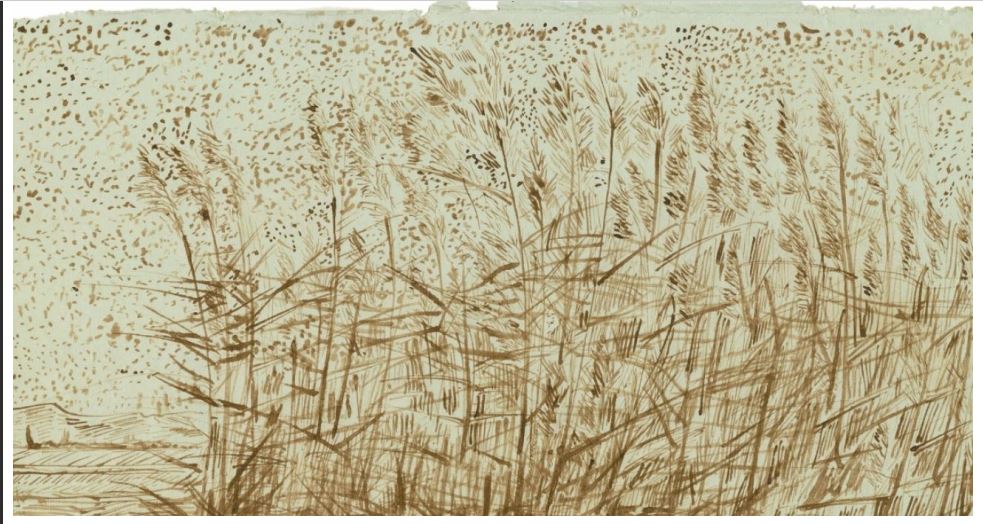
The sky, as in the previous sketch is without character and consequently without thought. Maybe there are examples of this in van Gogh's work, but it doesn't strike me as being characteristic.
One thing that bothered me a lot about this drawing, as an artist, was the neglect of the opportunity to extend the opposite shoreline, in a distinct way, into the weeds.
No! No! No! No! No! An obvious missed opportunity for the artist to be an artist enhancing the illusion of the piece. This type of thing would have been purged out of van Gogh's system very early on in his artistic life.
I don't think Van Gogh did this drawing.
I agree with the experts at the Van Gogh Museum. What I have seen, I do not believe is by Van Gogh.
Van Gogh is famous, among other things, for never selling a painting. I'm not sure if that is literally true. However, his dealer, brother Theo, died within a small number of months of Vincent's death. It was left to Theo's widow to create the market for Van Gogh's paintings, which she did with considerable skill, I believe.
As a consequence, fake Van Goghs started to appear not long after the artist's death. Are these fakes? I think so. There are serious violations of Van Gogh's aesthetic in what I have seen and a complete absence of his turn of mind, although stylistic tools that he used are certainly on display.
Now I want to go on to examine drawings which have been put forward as authentic pieces by Van Gogh, but which have been rejected by the Van Gogh Museum for numerous reasons, including ones related to connoisseurship.
I have only looked at four of these drawings, which have been published on line. I will not be addressing any forensic, or technical detail related to materials used or provenance. I will be pointing out things that caught my eye, as an artist, and which I believe would catch the eye of a Van Gogh connoisseur.
Brouillard Sketch 1:
This is the sketch that is featured on the cover of the soon to be released book, Vincent van Gogh. The Lost Arles Sketchbook.

When I first looked at this drawing, I thought, "Wow! This is interesting.", but the more I looked at it, and knowing that there was controversy, I thought, "This is very like Matisse in the background."
The next thing I noticed, which was a big red flag for me was the circled area at the left of the picture, the edge of the hat.
Artists are very interested in the edges of things and have numerous ways of drawing and not drawing them, for effect.
Here, the artist has drawn the edge of the hat and then left a lacuna between the hat and the rest of the background. It is my opinion that doing this part of the drawing in this way is a serious breach of Van Gogh's esthetic, even in a sketch.
One also can't fail to notice immediately, although I did fail to notice it, the large discrepancy between the irises of the two eyes. It would not surprise me in the least to find similar discrepancies in authenticated Van Gogh works, but this discrepancy seems particularly egregious, especially considering the deliberate, methodical way in which I believe Van Gogh "built" a drawing, in small increments, always comparing parts to make sure that they remained integral with the whole of the work.
The beard seems to me to be overworked in an untidy manner, not stylistically compatible with Van Gogh's other work.
The background also, is too busy, too random, too ill considered to be typical of Van Gogh.
In addition to the above, I want to make a subtle point.
My impression of this work is that it is the reverse of what one would expect from Van Gogh drawing, in which stylistic elements, "tools" really, are used to create a drawing as an expression of the artist's vision and conception.
In the case of this drawing my feeling is that a drawing was the starting point, which was used as a vehicle to display the "tools" of Van Gogh. In other words, the whole point of this particular work is not to express an artist's conception, but rather to express an artist's style.
This work was done by a real artist/forger, but not by Van Gogh, in my opinion.
Brouillard Sketch 2:
This next sketch, attributed to Van Gogh, is for me the most annoying of the ones I have seen, because it violates what I firmly believe was Van Gogh's basic modus operandi, which was to work all over the drawing, building it up, knitting it tightly together and keeping it integrated all the way.

In this sketch, the trees would appear to have been done first and the building and sky put in afterward. Note the long curving section of the tree trunk on the left, which was definitely carried well above the roof line in one passage of drawing. To me that is not typical of Van Gogh.
Notice how some windows are done very nicely and others are just indicated in a very cursory fashion. One might say, "Well it's a sketch and he was hurrying. He just didn't bother finishing them." Van Gogh, even in a simple sketch, doesn't operate that way, and this is not a simple sketch.
We have seen that he is neat and fastidious in his work.
Notice, circled at the right, the trailing edge of the sketch, the "no throw away zone", one might call it. Here it is thrown away. There is no peek at the background, no look at the distance, no invitation into the world of the drawing. It is very unlike Van Gogh to do that.
I don't think this drawing is by Van Gogh. It's a pastiche of things we see in his paintings. I am not a connoisseur of Van Gogh. I have not studied his work as an expert would. I am reacting as an artist. To me, this is a mess and Van Gogh is not messy.
Brouillard Sketch 3:
I have only looked at four of the drawings from the book. One of these, "water, sky and sail boats", for lack of a title, seems altogether too limp to be a Van Gogh. There is not much of mind or of life in it, in my opinion. If it lives, it is on life suport.

Brouillard Sketch 4:
This last sketch, of the four I looked at, is a pleasant drawing, showing some skill in the handling of the grasses in the foreground, but still, there is slapdash non Van Gogh-ian "filler" in there too.

The sky, as in the previous sketch is without character and consequently without thought. Maybe there are examples of this in van Gogh's work, but it doesn't strike me as being characteristic.
One thing that bothered me a lot about this drawing, as an artist, was the neglect of the opportunity to extend the opposite shoreline, in a distinct way, into the weeds.
No! No! No! No! No! An obvious missed opportunity for the artist to be an artist enhancing the illusion of the piece. This type of thing would have been purged out of van Gogh's system very early on in his artistic life.
I don't think Van Gogh did this drawing.
I agree with the experts at the Van Gogh Museum. What I have seen, I do not believe is by Van Gogh.
Van Gogh is famous, among other things, for never selling a painting. I'm not sure if that is literally true. However, his dealer, brother Theo, died within a small number of months of Vincent's death. It was left to Theo's widow to create the market for Van Gogh's paintings, which she did with considerable skill, I believe.
As a consequence, fake Van Goghs started to appear not long after the artist's death. Are these fakes? I think so. There are serious violations of Van Gogh's aesthetic in what I have seen and a complete absence of his turn of mind, although stylistic tools that he used are certainly on display.
edit on 16-11-2016 by ipsedixit because: (no reason given)
a reply to: LesMisanthrope
Thanks.
I think I might have been a little hard on the drawing of the boats in the water, but I don't think it is a Van Gogh.
Thanks.
I think I might have been a little hard on the drawing of the boats in the water, but I don't think it is a Van Gogh.
a reply to: ipsedixit
I'm no expert so i decided to look at other known sketches from Van Gogh and apparently some of these fakes were also in the photo galleries i had looked at and i was thinking these seem wrong.
I was right the one's that felt wrong were from this new book of sketches. They seem boring and uninspired as compared to known authentic sketches.
I think the best part of the evidence being that Van Gogh drew in black ink that turned brown and these were done with brown ink!
Thanks for making me think.
I'm no expert so i decided to look at other known sketches from Van Gogh and apparently some of these fakes were also in the photo galleries i had looked at and i was thinking these seem wrong.
I was right the one's that felt wrong were from this new book of sketches. They seem boring and uninspired as compared to known authentic sketches.
I think the best part of the evidence being that Van Gogh drew in black ink that turned brown and these were done with brown ink!
Thanks for making me think.
a reply to: SPHARAOH
I've have never seen any of this stuff before, myself. The Van Gogh Museum have done a quite thorough job of stating the case against these works.
One thing that I wonder about, is whether any of these were signed. If none were signed, it could simply be a case of someone working "after" Van Gogh, in the manner of a student, perhaps.
Anything signed would really be put under the critical microscope and if it failed to pass muster, we would know we are dealing with a definite forger.
I've have never seen any of this stuff before, myself. The Van Gogh Museum have done a quite thorough job of stating the case against these works.
One thing that I wonder about, is whether any of these were signed. If none were signed, it could simply be a case of someone working "after" Van Gogh, in the manner of a student, perhaps.
Anything signed would really be put under the critical microscope and if it failed to pass muster, we would know we are dealing with a definite forger.
a reply to: ipsedixit
Granted. Maybe that's why they aren't signed a little less scrutiny as you put it? I guess fake and forgery are interchangeable to some people. But there is a difference from what i have read in the past.
Granted. Maybe that's why they aren't signed a little less scrutiny as you put it? I guess fake and forgery are interchangeable to some people. But there is a difference from what i have read in the past.
edit on 16-11-2016 by SPHARAOH because: Autooooooocorrect
This is to return to the "boat sketch", Brouillard Sketch 3, above.
I mentioned that I thought I was being a little hard on it, but that I still didn't think that it was by Van Gogh. I actually like the treatment of the water in this drawing. It is interesting to look at in some detail and evocative of the movement of water currents, sometimes conflicting currents. As one recedes to the horizon, there is an attempt to give the visual impression of distance. Well and good. Van Gogh would do that.
However the sky contains no indication of perspective at all. Van Gogh would not do that, particularly in contrast to the way the water has been handled.
If this were a night sky and the dots were stars, one might think of "The Starry Night" and say, "Alright, this is a surrealist conception.", but even then, the notion conveyed by the drawing, interpreted in that way, strikes me as being too impersonal and distant to be coming from the sensibility of Van Gogh.
This drawing kept nagging me, so I wanted to clarify my impression of it.
Another thing, in the first of the "Brouillard" sketches, I pointed out a lacuna at the edge of the hat, which I thought uncharacteristic of Van Gogh. This is, almost certainly, an indication of the drawing, used as a guide for the ink applied later. The idea that Van Gogh himself would have left that anomalous space, curved like the edge of a hat brim, hanging in the air, is unacceptable to me.
I mentioned that I thought I was being a little hard on it, but that I still didn't think that it was by Van Gogh. I actually like the treatment of the water in this drawing. It is interesting to look at in some detail and evocative of the movement of water currents, sometimes conflicting currents. As one recedes to the horizon, there is an attempt to give the visual impression of distance. Well and good. Van Gogh would do that.
However the sky contains no indication of perspective at all. Van Gogh would not do that, particularly in contrast to the way the water has been handled.
If this were a night sky and the dots were stars, one might think of "The Starry Night" and say, "Alright, this is a surrealist conception.", but even then, the notion conveyed by the drawing, interpreted in that way, strikes me as being too impersonal and distant to be coming from the sensibility of Van Gogh.
This drawing kept nagging me, so I wanted to clarify my impression of it.
Another thing, in the first of the "Brouillard" sketches, I pointed out a lacuna at the edge of the hat, which I thought uncharacteristic of Van Gogh. This is, almost certainly, an indication of the drawing, used as a guide for the ink applied later. The idea that Van Gogh himself would have left that anomalous space, curved like the edge of a hat brim, hanging in the air, is unacceptable to me.
new topics
-
Comparing the theology of Paul and Hebrews
Religion, Faith, And Theology: 17 minutes ago -
Pentagon acknowledges secret UFO project, the Kona Blue program | Vargas Reports
Aliens and UFOs: 1 hours ago -
Boston Dynamics say Farewell to Atlas
Science & Technology: 1 hours ago -
I hate dreaming
Rant: 2 hours ago -
Is the origin for the Eye of Horus the pineal gland?
Philosophy and Metaphysics: 3 hours ago -
Man sets himself on fire outside Donald Trump trial
Mainstream News: 4 hours ago -
Biden says little kids flip him the bird all the time.
2024 Elections: 4 hours ago -
The Democrats Take Control the House - Look what happened while you were sleeping
US Political Madness: 4 hours ago -
Sheetz facing racial discrimination lawsuit for considering criminal history in hiring
Social Issues and Civil Unrest: 4 hours ago -
In an Historic First, In N Out Burger Permanently Closes a Location
Mainstream News: 6 hours ago
top topics
-
In an Historic First, In N Out Burger Permanently Closes a Location
Mainstream News: 6 hours ago, 14 flags -
The Democrats Take Control the House - Look what happened while you were sleeping
US Political Madness: 4 hours ago, 11 flags -
Thousands Of Young Ukrainian Men Trying To Flee The Country To Avoid Conscription And The War
Other Current Events: 17 hours ago, 8 flags -
A man of the people
Medical Issues & Conspiracies: 12 hours ago, 8 flags -
Man sets himself on fire outside Donald Trump trial
Mainstream News: 4 hours ago, 7 flags -
Biden says little kids flip him the bird all the time.
2024 Elections: 4 hours ago, 6 flags -
4 plans of US elites to defeat Russia
New World Order: 13 hours ago, 4 flags -
Pentagon acknowledges secret UFO project, the Kona Blue program | Vargas Reports
Aliens and UFOs: 1 hours ago, 4 flags -
Is the origin for the Eye of Horus the pineal gland?
Philosophy and Metaphysics: 3 hours ago, 4 flags -
Sheetz facing racial discrimination lawsuit for considering criminal history in hiring
Social Issues and Civil Unrest: 4 hours ago, 3 flags
active topics
-
The defamation of Mary Magdalene
Religion, Faith, And Theology • 15 • : Solvedit -
A man of the people
Medical Issues & Conspiracies • 9 • : tarantulabite1 -
Silent Moments --In Memory of Beloved Member TDDA
Short Stories • 47 • : Naftalin -
Thousands Of Young Ukrainian Men Trying To Flee The Country To Avoid Conscription And The War
Other Current Events • 38 • : DBCowboy -
George Knapp AMA on DI
Area 51 and other Facilities • 28 • : theshadowknows -
Pentagon acknowledges secret UFO project, the Kona Blue program | Vargas Reports
Aliens and UFOs • 4 • : Ophiuchus1 -
Comparing the theology of Paul and Hebrews
Religion, Faith, And Theology • 0 • : DISRAELI2 -
12 jurors selected in Trump criminal trial
US Political Madness • 107 • : Xtrozero -
Man sets himself on fire outside Donald Trump trial
Mainstream News • 30 • : HatesFreshAir -
The Democrats Take Control the House - Look what happened while you were sleeping
US Political Madness • 36 • : DBCowboy
11
